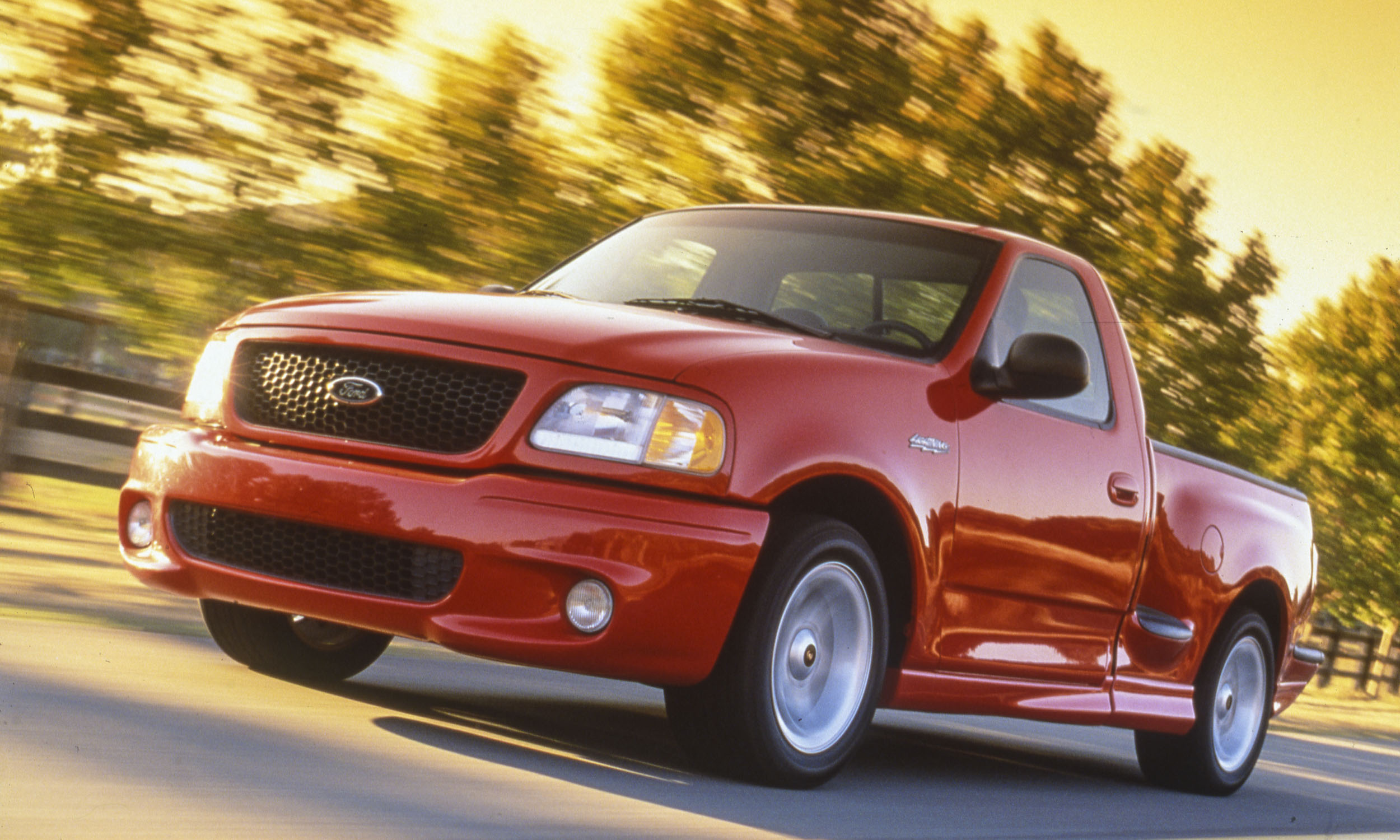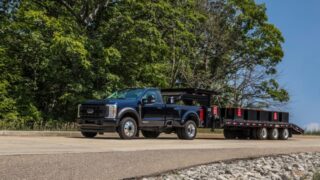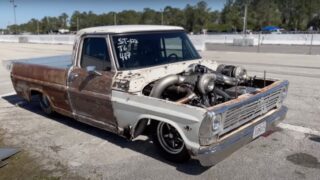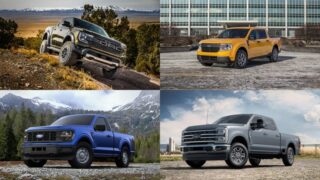Ford’s Next Surprise: The 2018 F-150 Lightning

Those keeping score know sales volume and average transaction price are key metrics in the full-size truck wars. And it’s no secret the Detroit Three are thinking about looming fuel economy challenges.
“Thanks to the intensive use of aluminum, the sum of the weight savings on the 2015 trucks will be over 150,000 tons. In other words, Ford will remove the equivalent of one-and-a-half Nimitz Class super carriers from the weight of its F-150s this year.”
The Blue Oval will sell more F-150s this year than it did last year, and thanks to the intensive use of aluminum, the sum of the weight savings on the 2015 trucks will be over 150,000 tons. In other words, Ford will remove the equivalent of one-and-a-half Nimitz Class super carriers from the weight of its F-150s this year.
Right now, Ford is having tens-of-thousands of tons of fun winning, so naturally, enthusiasts are going to be thinking about what’s next.
Ford’s aluminum decision, made in 2009, is finally bearing fruit. Some consumers may approach the material with skepticism, but the major hurdles have been overcome. The transition to designing and manufacturing with the more challenging material have been largely overcome, and supply constraints are well on their way to being addressed.
Additionally, the Ford communications people have done an admirable job massaging the perception of stubborn truck buyers, and loyalty remains high.
But Ford didn’t make the massive financial, structural, human, and supply chain investments in aluminum to stop with its mainstream half-ton and two-ton trucks. The company will leverage its hard-won expertise in aluminum to reduce weight and improve fuel economy of other body-on-frame products as they come due for redesign. For example, in the fall of 2016, the new aluminum-intensive Super Duty will be released. And around the same time, the 55,000-unit-a-year Expedition/Navigator twins will transition to the aluminum-intensive F-150 platform.

Meanwhile, the Ford Performance team is also updating the wildly successful Raptor—See 5 Reasons to Wait for the 2017 Raptor—and the high-speed off-roader is also getting the aluminum treatment, along with numerous Raptor-only modifications. Expect extensive suspension updating, bolder bodywork, and—most importantly—a new engine. In conjunction with the new light-weight F-150 platform, the new engine is pivotal, because it enables Ford to add yet another aspirational product to its arsenal.
“Ford has already made the platform and drivetrain investments It simply needs to do some suspension and packaging work to make the new Lightning a reality. And the lack of competition and continued low fuel prices make timing for a new Lightning opportune.”
That’s right, everything is coming together. Lightning is about to strike.
Ford’s new rigid, light-weight architecture is proven and available. And with the new Raptor set to start shipping in a few months, the engineering and integration work on its new high-performance 3.5L EcoBoost is likely complete. The 3.5L EcoBoost currently available in Ford trucks produces a competitive 365 horsepower at 5,000 rpm and 420 lb-ft of torque at 2,500 rpm, and while output for the new Raptor mill hasn’t been announced, horsepower will certainly exceed 450. Some outlets are even estimating over 500 horsepower will be on tap.
Regardless, the new Raptor will have at least a 50 horsepower and 50 lb-feet of torque advantage over its current 6.2L normally aspirated V8. Plus, the 2017 Raptor will weigh at least 600 pounds less than the current version.
When performance benchmarking a new Lightning, it’s instructive to compare it with an in-house rival, the Mustang GT. In 2004 the Lightning and Mustang GT came in at 12.3 and 12.8 pounds per horsepower, respectively. And both vehicles delivered 0-60 times in the low fives. The mathematics of acceleration is more involved than a simple pound-per-horsepower calculation, but nonetheless, it’s instructional. If Ford wishes to maintain parity between the Mustang GT and a new regular cab Lightning, the truck needs to deliver—an easily attainable—485 horsepower.
Ford has made the platform and drive train investments already. So it simply needs to do some suspension and packaging work to make the new Lightning a reality. The last Lightning exited the lineup in 2004 after selling between 3,800 and 6,400 units in each of its last five years. The performance truck segment hasn’t been robust over the last decade, and there haven’t been truly credible participants.
But the lack of competition and continued low fuel prices make the timing for a new Lightning opportune. And since the Lightning will be a niche product aimed at a narrow, easy-to-reach audience, the marketing commitment should be relatively modest.

The Lightning will likely be offered in Ford’s regular cab, short-bed configuration, and expect the company to broaden its appeal by also offering a family-friendly crew cab short-bed. This layout will add about 400 pounds, and to maintain parity with the Mustang GT, increase the horsepower requirement to 535. But this elevated output should be attainable, particularly given that the derivative Ford GT engine produces more than 600 horsepower.
“Keeping pricing in check—as it has done with the Raptor—will be key, but if the company can make the numbers work, we’ll see an inordinate number of new homes for a vehicle with an ostensibly ‘niche’ appeal. Unfortunately, don’t expect a manual transmission option.”
Keeping pricing in check—as it has done with the Raptor—will be key, but if the company can make the numbers work, we’ll see an inordinate number of new homes for a vehicle with an ostensibly “niche” appeal.
The market may not even require a full 535 horsepower for the Lightning to be successful. If other truck sales are an indication, the crew cab configuration will be vastly more popular than the regular cab, even if it gives up a couple tenths of a second to 60 miles per hour versus its regular cab cousin. A 485 horsepower solution would enable Ford to market the truck’s breakneck acceleration in the regular cab while simultaneously offering four-door practicality in a package with demonstrably similar performance.
Ultimately, the revived Lightning will get a very similar tune to whatever Ford determines it needs to achieve its cost and performance objectives for the Raptor. Unfortunately, don’t expect a manual transmission option—we’ve covered that ground before—as the Lightning will get the same ten-speed automatic being prepared for duty in the 2017 Raptor.
The Lightning nameplate has positive equity, but for the enthusiasts this product is primarily aimed at, it may not actually matter what badge Ford puts on the truck. A true low-slung, high-output F-150 will drive passionate buyers, regardless of its name. A new performance truck is a low-cost, low-risk way for Ford to extend its truck leadership and reenter a market segment devoid of competition.
Watch for the new Lightning in late 2017.




